Chap02Thinking Like an Economist(曼昆经济学原理,微观-英文版)
曼昆《经济学原理》Chapter 02
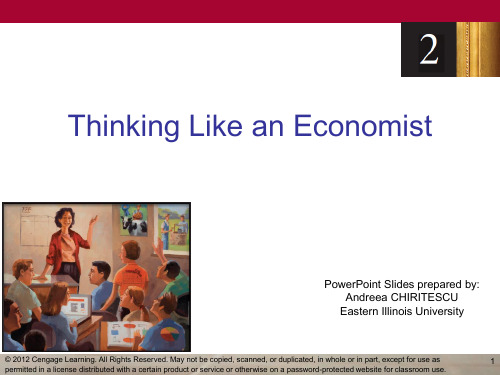
10
Figure 2
The production possibilities frontier
Quantity of Computers Produced
3,000 2,200 2,000 F C The production possibilities frontier shows the combinations of output—in this case, cars and computers— that the economy can possibly produce. The economy can produce any combination on or inside the frontier. Points outside the frontier are not feasible given the economy’s resources.
6
The Economist as a Scientist
• Firms
– Produce goods and services – Use factors of production / inputs
• Households
– Own factors of production – Consume goods and services
© 2012 Cengage Learning. All Rights Reserved. May not be copied, scanned, or duplicated, in whole or in part, except for use as permitted in a license distributed with a certain product or service or otherwise on a password-protected website for classroom use.
Chap02像经济学家一样思考(经济学原理,曼昆,中英文双语)
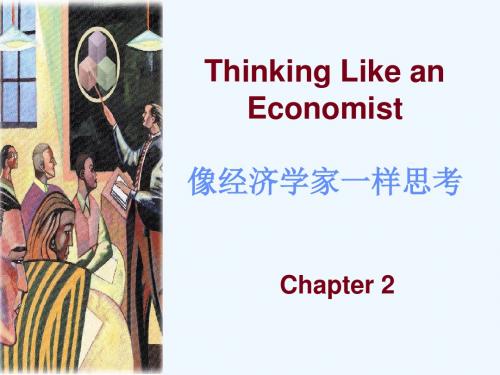
E
A
0
700 750
1,000
汽车产量
Microeconomics and Macroeconomics
u
Microeconomics focuses on the individual parts of the economy.
u
How households and firms make decisions and how they interact in specific markets
u u
家庭出售 企业购买
The Circular-Flow Diagram 经济循环图
Factors of Production 生产要素
u
Inputs used to produce goods and services 用于生产物品与劳务的投入
u
Land, labor, and capital
Market for Factors of Production
Labor, land, and capital Income
经济循环图
收入 销售商品 和服务 支出
物品与劳务 市场
购买商品 和服务
企业
家庭
生产投入
工资、租金 和利润
生产要素 市场
劳动、土地 和资本
收入
Figure 1 The Circular Flow
Economics
Supply Opportunity cost Elasticity
Comparative advantage
Consumer Surplus Demand Deadweight loss
每个研究领域都有自己的语言
经济学
经济学原理曼昆Chapter 02
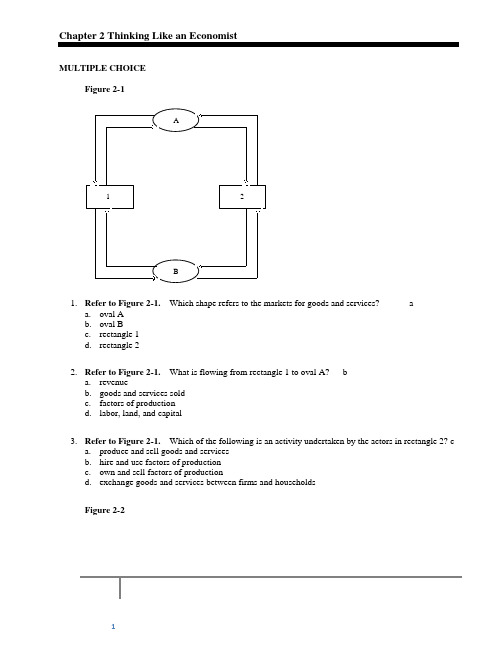
Chapter 2 Thinking Like an EconomistMULTIPLE CHOICEFigure 2-1AB 211. Refer to Figure 2-1.Which shape refers to the markets for goods and services? aa. oval Ab. oval Bc. rectangle 1d. rectangle 22. Refer to Figure 2-1.What is flowing from rectangle 1 to oval A? ba. revenueb. goods and services soldc. factors of productiond. labor, land, and capital3. Refer to Figure 2-1.Which of the following is an activity undertaken by the actors in rectangle 2? ca. produce and sell goods and servicesb. hire and use factors of productionc. own and sell factors of productiond. exchange goods and services between firms and householdsFigure 2-212345678910Consider the production possibilities curve for a country that can produce cars, corn (in bushels), or a combination of the two. 4. Refer to Figure 2-2. If this economy devotes all of its available resources to producing corn, then itwill produce da. 0 bushels of corn and 10 cars.b. 135 bushels of corn and 3 carsc. 160 bushels of corn and 10 cars.d. 160 bushels of corn and 0 cars.5. Refer to Figure 2-2. Which combination of points show production possibilities only achievablewith improvements in technology or increases in resources? da. A, D, and Eb. B and Gc. C and Fd. None of the above is correct.6. Refer to Figure 2-2. If this society moves from point D to point E, da. it gives up 25 bushels of corn to get 3 cars.b. it gives up 135 bushels of corn to get 3 cars.c. it gives up 3 cars to get 135 bushels of corn.d. it gives up 3 cars to get 25 bushels of corn.7. Refer to Figure 2-2. If this society is producing at point C, da. there is unemployment.b. production is efficient.c. growth can only be achieved through an advancement in technology.d. the opportunity cost of producing one more car is approximately 10 bushels of corn.8. Which of the following is a positive, as opposed to a normative, statement? ba. The US Department of Justice should allow a merger between AT&T and T-Mobilebecause it would have little effect on consumers.b. Antitrust laws should be used to prevent further concentration in the wireless telephoneservice market.c. The US Department of Justice sued AT&T to block its merger with T-Mobile.d. The wireless telephone service market is too highly concentrated.9. Which of the following famous people did not major in economics in college? ba. Donald Trumpb. Natalie Portmanc. John Elwayd. Mick Jagger10. Which of the following statements is correct about environmental economists? da. They view economics as a framework for natural resource allocation.b. They work at government agencies as well as universities and advocacy groups.c. They use economic arguments and systems to persuade companies to clean up pollutionand conserve natural resources.d. All of the above are correct.11. In the ordered pair (20, 100), 20 is the aa. x-coordinate.b. y-coordinate.c. scatterplot.d. slope.12. Between the two ordered pairs (20, 100) and (30, 80), the slope is ba. 1/2.b. -1/2.c. 2.d. -2.Figure 2-4snowblowers solds n o w s t o r ms 1020304050607080901234567891013. Refer to Figure 2-4. According to the graph, snowstorms aa. and snowblowers sold are positively correlated.b. and snowblowers sold are negatively correlatedc. and snowblowers sold are uncorrelated.d. are caused by more snowblowers being sold.14. Refer to Figure 2-4.Your friend John created the graph above to illustrate that snowstorms arecaused by more snowblowers being sold. You inform him that his interpretation is incorrect due to aa. omitted variable bias.b. reverse causality.c. slope mismatch.d. shifting versus moving along a curve.15. Refer to Figure 2-4.Which of the following could be an omitted variable in the graph? da. the price of snowblowersb. a change in consumers’ incomesc. a change in the seasonsd. All of the above are correct.PROBLEMFigure 2-1AB 211. Refer to Figure 2-1. What is the name of the model depicted in the figure?The Circular Flow2. Refer to Figure 2-1. What do the ovals represent in the figure?A: Markets for goods and service B: Markets for factors of production 3. Refer to Figure 2-1. What do the rectangles represent in the figure?1:Firms 2:Households4. Refer to Figure 2-1. What do the outer arrows represent in the figure?A to 1:revenue 1 toB :wages,rent, and profit B to 2 income 2 to A :spending 5.Refer to Figure 2-1. What do the inner arrows represent in the figure? A to 2:goods and services bought 2 to B:Labor,land,and capital B to1:Factors of production 1 to A: goods and services sold6. Refer to Figure 2-1. What does the arrow going from oval A to rectangle 2 represent in the figure? A to 2:goods and services bough7. Refer to Figure 2-1. What does the arrow going from oval B to rectangle 2 represent in the figure? B to 2 income 8.Refer to Figure 2-1. What are two elements not included in this figure that could be included in a more complex model? 9. The three main factors of production, or categories of inputs, used by firms to produce goods andservices areFigure 2-212345678910Consider the production possibilities curve for a country that can produce cars, corn (in bushels), or a combination of the two. 10.Refer to Figure 2-2. The bowed outward shape of the production possibilities curve indicates that opportunity cost of corn in terms of cars is 11.Refer to Figure 2-2. Which point(s) on the graph is(are) efficient production possibilities? 12.Refer to Figure 2-2. Which point(s) on the graph show unemployment of resources? 13. Refer to Figure 2-2. Which point(s) on the graph is(are) unattainable given current resources andtechnology?14.Who would be more likely to study the effects of government spending on the unemployment rate, a macroeconomist or a microeconomist? 15.Who would be more likely to study the effects of foreign competition on the accounting industry, a macroeconomist or a microeconomist? 16.Who would be more likely to study the effects of rent control on housing in New York City, a macroeconomist or a microeconomist? 17.Who would be more likely to study the inflation rate in the United States, a macroeconomist or a microeconomist? 18.Is the following a positive or normative statement? The federal minimum wage is lower than many state minimum wages. 19.Is the following a positive or normative statement? The Federal Reserve should set an inflation target and employ policies to meet the target. 20.Is the following a positive or normative statement? The United States government should mandate that every citizen purchases health insurance. 21. Is the following a positive or normative statement? The unemployment rate in Nevada is higher thanthe unemployment rate in New York.10203040506070801234567891022. Refer to Figure 2-3. What are the coordinates of point C?23. Refer to Figure 2-3. How are price and quantity related in this graph?24. Refer to Figure 2-3.What is the slope of the line?25. Refer to Figure 2-3.Is a move from point A to point B considered a shift of the curve or amovement along the curve?。
《西方经济学》双语课件PPTch02-Thinking Like An Economist
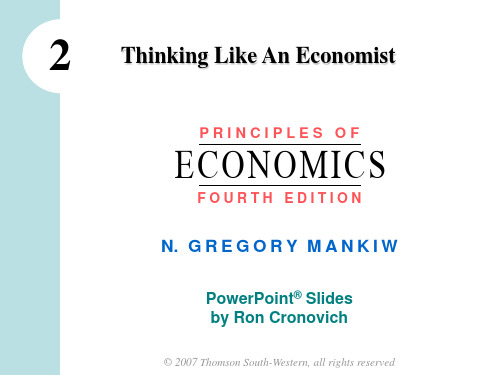
▪ What is the difference between microeconomics and
macroeconomics? Between positive and normative?
▪ Includes two types of “actors”:
• households • firms
▪ Includes two markets:
• the market for goods and services • the market for “factors of production”
▪ What are the elements of the Circular-Flow Diagram?
What concepts does this diagram illustrate?
▪ How is the Production Possibilities Frontier related
5
Some Familiar Models
A model airplane
CHAPTER 2 THINKING LIKE AN ECONOMIST
6
Some Familiar Models
The model teeth at the dentist’s office
Don’t forget to floss!
2
Assumptions & Models
▪ Assumptions simplify the complex world,
make it easier to understand.
Chpt_2 Thinking Like an Economist
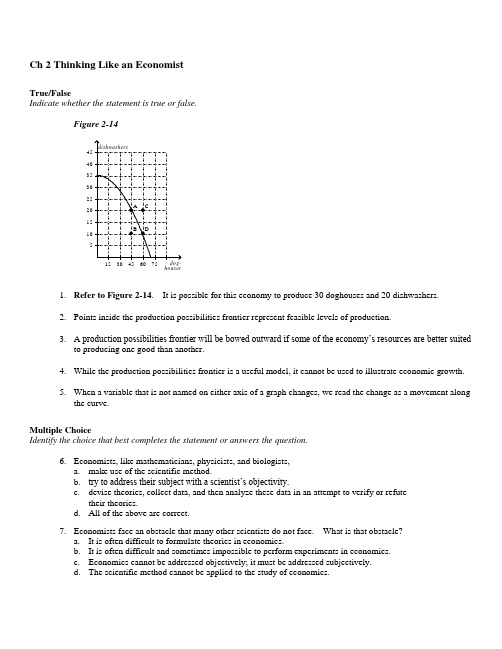
Ch 2 Thinking Like an EconomistTrue/FalseIndicate whether the statement is true or false.Figure 2-14153********1015202530354045____1. Refer to Figure 2-14. It is possible for this economy to produce 30 doghouses and 20 dishwashers. ____2. Points inside the production possibilities frontier represent feasible levels of production. ____3. A production possibilities frontier will be bowed outward if some of the economy’s resources are better suited to producing one good than another. ____4. While the production possibilities frontier is a useful model, it cannot be used to illustrate economic growth. ____5. When a variable that is not named on either axis of a graph changes, we read the change as a movement alongthe curve.Multiple ChoiceIdentify the choice that best completes the statement or answers the question.____ 6. Economists, like mathematicians, physicists, and biologists,a. make use of the scientific method.b. try to address their subject with a scientist’s objectivity.c. devise theories, collect data, and then analyze these data in an attempt to verify or refutetheir theories. d. All of the above are correct.____ 7. Economists face an obstacle that many other scientists do not face. What is that obstacle? a. It is often difficult to formulate theories in economics.b. It is often difficult and sometimes impossible to perform experiments in economics.c. Economics cannot be addressed objectively; it must be addressed subjectively.d. The scientific method cannot be applied to the study of economics.____ 8. In conducting their research, economists face an obstacle that not all scientists face; specifically, in economics, it is often difficult and sometimes impossible toa. make use of theory and observation.b. rely upon the scientific method.c. conduct laboratory experiments.d. find articles or books that were written before 1900.____ 9. Which of the following statements is (are) correct?a. Relative to other scientists, economists find it more difficult to generate useful data.b. Theory and observation are important in economics as well as in other sciences.c. To obtain data, economists often rely upon the natural experiments offered by history.d. All of the above are correct.____ 10. Which of the following statements about models is correct?a. The more details a model includes, the better the model.b. Models assume away irrelevant details.c. Models cannot be used to explain how the economy functions.d. Models cannot be used to make predictions.____ 11. Economic models are built witha. recommendations concerning public policies.b. facts about the legal system.c. assumptions.d. statistical forecasts.____ 12. The circular-flow diagram is aa. visual model of the economy.b. visual model of the relationships among money, prices, and businesses.c. model that shows the effects of government on the economy.d. mathematical model of how the economy works.____ 13. Factors of production area. the mathematical calculations firms make in determining their optimal production levels.b. social and political conditions that affect production.c. the physical relationships between economic inputs and outputs.d. inputs into the production process.____ 14. In the circular-flow diagram, in the markets fora. goods and services, households and firms are both sellers.b. goods and services, households are buyers and firms are sellers.c. the factors of production, households are buyers and firms are sellers.d. the factors of production, households and firms are both buyers.____ 15. In the circular-flow diagram, in the markets fora. goods and services, households and firms are both sellers.b. goods and services, households are sellers and firms are buyers.c. the factors of production, households are sellers and firms are buyers.d. the factors of production, households and firms are both buyers.____ 16. Which of the following transactions does not take place in the markets for factors of production in the circular-flow diagram?a. a landowner leases land to a farmerb. a farmer hires a teenager to help with harvestc. a retired farmer sells his combine to a new farmerd. a woman buys corn for dinner____ 17. In the circular-flow diagram, which of the following items represents a payment for a factor of production?a. interestb. capitalc. spending by households on goodsd. spending by households on servicesFigure 2-2____ 18. Refer to Figure 2-2.If Box A of this circular-flow diagram represents firms, then which box represents households?a. Box Bb. Box Cc. Box Dd. Any one of the other boxes (B, C, or D) could represent households.____ 19. Which of the following is a correct statement about production possibilities frontiers?a. An economy can produce only on the production possibilities frontier.b. An economy can produce at any point inside or outside a production possibilities frontier.c. An economy can produce at any point on or inside the production possibilities frontier, butnot outside the frontier.d. An economy can produce at any point inside the production possibilities frontier, but noton or outside the frontier.____ 20. If an economy is producing efficiently, thena. there is no way to produce more of one good without producing less of another good.b. it is possible to produce more of both goods without increasing the quantities of inputs thatare being used.c. it is possible to produce more of one good without producing less of another good.d. it is not possible to produce more of any good at any cost.____ 21. Which of the following trade-offs does the production possibilities frontier illustrate?a. if an economy wants to increase efficiency in production, then it must sacrifice equality inconsumptionb. once an economy has reached the efficient points on its production possibilities frontier,the only way of getting more of one good is to get less of the otherc. for an economy to consume more of one good, it must stop consuming the other goodentirelyd. for an economy to produce and consume goods, it must sacrifice environmental quality____ 22. If a production possibilities frontier is bowed outward, then the opportunity cost of producing more of the first good is highest whena. the economy is producing much of the first good and little of the second good.b. the economy is producing equal amounts of the first and second goods.c. the economy is producing little of the first good and much of the second good.d. None of the above is correct because the opportunity cost of producing more of the firstgood is constant.____ 23. Economists believe that production possibilities frontiersa. never have a bowed shape.b. rarely have a bowed shape.c. often have a bowed shape.d. always have a bowed shape.Table 2-2Production Possibilities for Batterland____ 24. Refer to Table 2-2. What is the opportunity cost to Batterland of increasing the production of pancakes from 150 to 300?a. 75 wafflesb. 150 wafflesc. 250 wafflesd. 325 wafflesFigure 2-3____ 25. Refer to Figure 2-3. At which point is this economy producing its maximum possible quantity of tubas?a. Jb. Lc. Md. N____ 26. Refer to Figure 2-3. This economy cannot produce at which point(s)?a. Jb. J, Lc. J, L, Md. LFigure 2-5306090120150180210240270300330255075100125150175200225____ 27. Refer to Figure 2-5. A movement from point C to point D could be caused by a. unemployment.b. a decrease in society's preference for bananas.c. fewer resources available for production of bananas.d. All of the above are correct.Figure 2-624681012141651015202530354045____ 28. Refer to Figure 2-6. This economy cannot produce at which point(s)?a. A, B, Db. C, D, F, Gc. C, F, Gd. DFigure 2-8Panel (a) Panel (b)1234560.511.522.533.544.555.566.571234560.511.522.533.544.555.566.57____ 29. Refer to Figure 2-8, Panel (a). In order to gain 2 donuts by moving from point L to point M, society mustsacrificea. efficiency.b. employment.c. 4 cups of coffee.d. More than one of the above is correct.Figure 2-10batteriesBAbagels____ 30. Refer to Figure 2-10.Which of the following events would explain the shift of the production possibilities frontier from A to B?a. The economy’s citizens developed an enhanced taste for batteries.b. The economy experienced a technological advance in the production of batteries.c. More capital became available in the economy.d. More labor became available in the economy.____ 31. The field of economics is traditionally divided into two broad subfields,a. national economics and international economics.b. consumer economics and producer economics.c. private sector economics and public sector economics.d. microeconomics and macroeconomics.____ 32. Economists speaking like policy advisers makea. positive statements.b. descriptive statements.c. claims about how the world is.d. claims about how the world should be.____ 33. “Prices rise when the quantity of money rises rapidly” is an example of aa. negative economic statement.b. positive economic statement.c. normative economic statement.d. statement that contradicts one of the basic principles of economics.____ 34. The Council of Economic Advisersa. was created in 1946.b. advises the president of the United States on economic policy matters.c. writes the annual Economic Report of the President.d. All of the above are correct.____ 35. Economists sometimes give conflicting advice becausea. graduate students in economics are encouraged to argue with each other.b. economists have different values and scientific judgment.c. economists acting as scientists do not like to agree with economists acting as policyadvisers.d. economics is more of a belief system than a science.____ 36. Sometimes economists disagree because their scientific judgments differ. Which of the following instances best reflects this source of disagreement?a. One economist believes income tax cuts are unfair to those with low incomes; anothereconomist believes income tax cuts are not unfair to those with low incomes.b. One economist believes unemployment causes more human suffering than does inflation;another economist believes inflation causes more human suffering than doesunemployment.c. One economist believes the policies of the Democratic party offer the best hope forAmerica's future; another economist believes the policies of the Republican party offer thebest hope for America's future.d. One economist believes increases in the minimum wage increase unemployment; anothereconomist believes increases in the minimum wage do not increase unemployment.____ 37. A survey of professional economists revealed that more than three-fourths of them agreed with fourteen economic propositions. Which of the following is not one of those propositions?a. A ceiling on rents reduces the quantity and quality of housing available.b. Fiscal policy has a significant stimulative impact on a less than fully employed economy.c. The gap between Social Security funds and expenditures will become unsustainably largewithin the next fifty years if current policies remain unchanged.d. The United States should implement universal health care for its citizens.____ 38. How did the influential economist John Maynard Keynes explain his remark that although economics is an easy subject compared with the higher branches of philosophy or pure science, it is a subject at which fewexcel?a. Most people who study economics are not very bright.b. Good economists must possess a rare combination of gifts.c. Economics is quite boring; hence, people tend to lose interest in it before mastering it.d. Good thinkers become frustrated with economics because it does not make use of thescientific method.____ 39. The slope of a line is equal toa. the change in the value of x divided by the change in the value of y.b. the change in the value of y divided by the change in the value of x.c. the horizontal distance divided by the vertical distance.d. the value of y divided by the value of x.____ 40. Bill has noticed that increases in unemployment insurance claims are associated with recessions, and therefore he advocates limits on unemployment insurance so as to prevent recessions. Martha has noticedthat most drug addicts once attended schools, and therefore she advocates getting rid of schools so as toprevent drug addiction.a. The reasoning of both Bill and Martha suffers from the omitted variable problem.b. The reasoning of both Bill and Martha suffers from the reverse causality problem.c. Bill's reasoning suffers from the reverse causality problem, and Martha's reasoning suffersfrom the omitted variable problem.d. Martha's reasoning suffers from the reverse causality problem, and Bill's reasoning suffersfrom the omitted variable problem.Short Answ er41. Using the outline below, draw a circular-flow diagram representing the interactions between households andfirms in a simple economy. Explain briefly the various parts of the diagram.42. The prairie dog has always been considered a problem for American cattle ranchers. They dig holes thatcattle and horses can step in, and they eat grass necessary for cattle. Recently, ranchers have discovered that there is a demand for prairie dogs as pets. In some areas, prairie dogs can sell for as high as $150 each.Cattlemen are now fencing off prairie dog towns on their land so these towns will not be disturbed by theircattle.Draw a rancher’s production possibilities frontier showing increasing opportunity cost of cattle production interms of prairie dog production. Using a separate graph for each situation, show what would happen to theinitial production possibilities frontier in each of the following situations:a. The outcome is efficient, with ranchers choosing to produce equal numbers of cattle andprairie dogs.b. As a protest against the government introducing the gray wolf back into the wild in theirstate, ranchers decide to withhold 25 percent of the available grassland for grazing.c. The price of prairie dogs increases to $200 each, so ranchers decide to allot additionalland for prairie dogs.d. The government grants new leases to ranchers, giving them 10,000 new acres ofgrassland each for grazing.e. A drought destroys most of the available grass for grazing of cattle, but not for prairiedogs since they also eat plant roots.43. Draw a production possibilities frontier showing increasing opportunity cost of hammers in terms ofhorseshoes.a. On the graph, identify the area of feasible outcomes and the area of infeasible outcomes.b. On the graph, label a point that is efficient and a point that is inefficient.c. On the graph, illustrate the effect of the discovery of a new vein of iron ore, a resourceneeded to make both horseshoes and hammers, on this economy.d. On a second graph, illustrate the effect of a new computerized assembly line in theproduction of hammers on this economy.44. Identify each of the following topics as being part of microeconomics or macroeconomics:a. the impact of a change in consumer income on the purchase of luxury automobilesb. the effect of a change in the price of Coke on the purchase of Pepsic. the impact of a war in the Middle East on the rate of inflation in the United Statesd. factors influencing the rate of economic growthe. factors influencing the demand for tractorsf. the impact of tax policy on national savingg. the effect of pollution taxes on the U.S. copper industryh. the degree of competition in the cable television industryi. the effect of a balanced-budget amendment on economic stabilityj. the impact of deregulation on the savings and loan industry45. Which of the following statements are positive and which are normative?a. The minimum wage creates unemployment among young and unskilled workers.b. The minimum wage ought to be abolished.c. If the price of a product in a market decreases, then, other things equal, quantity demanded willincrease.d. A little bit of inflation is worse for society than a little bit of unemployment.e. There is a tradeoff between inflation and unemployment in the short run.f. If consumer income increases, then, other things equal, the demand for automobiles willincrease.g. The U.S. income distribution is not fair.h. U.S. workers deserve more liberal unemployment benefits.i. If interest rates increase, then investment will decrease.j. If welfare benefits were reduced, then the country would be better off.46. Use the following graph to answer the following questions.a. How would point J be represented as an ordered pair?b. What type of curve is this?c. Does this curve show a positive or negative correlation between price and quantity?d. Compute the slope of D1 between points J and L.e. What is the slope of D1 between points L and N? Why would you not have tocalculate this answer?f. What is it called if we move from D1 to D2?g. How do you know that the slope of D2 is the same as the slope of D1?1020304050607080481216202428323640Ch 2 Thinking Like an EconomistAnswer SectionTRUE/FALSE1. ANS: T PTS: 1 DIF: 2 REF: 2-1NAT: Analytic LOC: Understanding and applying economic modelsTOP: Production possibilities frontier MSC: Applicative2. ANS: T PTS: 1 DIF: 2 REF: 2-1NAT: Analytic LOC: Understanding and applying economic modelsTOP: Production possibilities frontier MSC: Interpretive3. ANS: T PTS: 1 DIF: 2 REF: 2-1NAT: Analytic LOC: Understanding and applying economic modelsTOP: Production possibilities frontier MSC: Interpretive4. ANS: F PTS: 1 DIF: 2 REF: 2-1NAT: Analytic LOC: Understanding and applying economic modelsTOP: Production possibilities frontier | Economic growth MSC: Interpretive5. ANS: F PTS: 1 DIF: 2 REF: 2-5NAT: Analytic LOC: The study of economics and definitions in economicsTOP: Graphs MSC: InterpretiveMULTIPLE CHOICE6. ANS: D PTS: 1 DIF: 2 REF: 2-1NAT: Analytic LOC: The study of economics and definitions in economicsTOP: Economists MSC: Interpretive7. ANS: B PTS: 1 DIF: 2 REF: 2-1NAT: Analytic LOC: The study of economics and definitions in economicsTOP: Economists MSC: Interpretive8. ANS: C PTS: 1 DIF: 2 REF: 2-1NAT: Analytic LOC: The study of economics and definitions in economicsTOP: Economists MSC: Interpretive9. ANS: D PTS: 1 DIF: 2 REF: 2-1NAT: Analytic LOC: The study of economics and definitions in economicsTOP: Economists MSC: Interpretive10. ANS: B PTS: 1 DIF: 2 REF: 2-1NAT: Analytic LOC: Understanding and applying economic modelsTOP: Economic models MSC: Interpretive11. ANS: C PTS: 1 DIF: 2 REF: 2-1NAT: Analytic LOC: Understanding and applying economic modelsTOP: Economic models MSC: Interpretive12. ANS: A PTS: 1 DIF: 1 REF: 2-1NAT: Analytic LOC: Understanding and applying economic modelsTOP: Circular-flow diagram MSC: Definitional13. ANS: D PTS: 1 DIF: 1 REF: 2-1NAT: Analytic LOC: The study of economics and definitions in economicsTOP: Factors of production MSC: Definitional14. ANS: B PTS: 1 DIF: 1 REF: 2-1NAT: Analytic LOC: Understanding and applying economic modelsTOP: Circular-flow diagram MSC: Definitional15. ANS: C PTS: 1 DIF: 1 REF: 2-1NAT: Analytic LOC: Understanding and applying economic modelsTOP: Circular-flow diagram | Factor markets MSC: Definitional 16. ANS: D PTS: 1 DIF: 2 REF: 2-1NAT: Analytic LOC: Understanding and applying economic modelsTOP: Circular-flow diagram | Factor markets MSC: Applicative 17. ANS: A PTS: 1 DIF: 2 REF: 2-1NAT: Analytic LOC: Understanding and applying economic modelsTOP: Circular-flow diagram MSC: Interpretive18. ANS: A PTS: 1 DIF: 2 REF: 2-1NAT: Analytic LOC: Understanding and applying economic modelsTOP: Circular-flow diagram MSC: Interpretive19. ANS: C PTS: 1 DIF: 2 REF: 2-1NAT: Analytic LOC: Understanding and applying economic modelsTOP: Production possibilities frontier MSC: Interpretive20. ANS: A PTS: 1 DIF: 2 REF: 2-1NAT: Analytic LOC: Efficiency and equality TOP: Efficiency MSC: Interpretive21. ANS: B PTS: 1 DIF: 2 REF: 2-1NAT: Analytic LOC: Understanding and applying economic modelsTOP: Production possibilities frontier MSC: Interpretive22. ANS: A PTS: 1 DIF: 2 REF: 2-1NAT: Analytic LOC: Understanding and applying economic modelsTOP: Production possibilities frontier | Opportunity cost MSC: Interpretive 23. ANS: C PTS: 1 DIF: 2 REF: 2-1NAT: Analytic LOC: Understanding and applying economic modelsTOP: Production possibilities frontier | Economists MSC: Interpretive 24. ANS: A PTS: 1 DIF: 2 REF: 2-1NAT: Analytic LOC: Scarcity, tradeoffs, and opportunity costTOP: Opportunity cost MSC: Interpretive25. ANS: D PTS: 1 DIF: 2 REF: 2-1NAT: Analytic LOC: Understanding and applying economic modelsTOP: Production possibilities frontier MSC: Applicative26. ANS: B PTS: 1 DIF: 2 REF: 2-1NAT: Analytic LOC: Understanding and applying economic modelsTOP: Production possibilities frontier MSC: Applicative27. ANS: A PTS: 1 DIF: 2 REF: 2-1NAT: Analytic LOC: Understanding and applying economic modelsTOP: Production possibilities frontier | Unemployment MSC: Applicative 28. ANS: D PTS: 1 DIF: 2 REF: 2-1NAT: Analytic LOC: Understanding and applying economic modelsTOP: Production possibilities frontier MSC: Applicative29. ANS: C PTS: 1 DIF: 3 REF: 2-1NAT: Analytic LOC: Understanding and applying economic modelsTOP: Production possibilities frontier | Opportunity cost MSC: Analytical 30. ANS: B PTS: 1 DIF: 2 REF: 2-1NAT: Analytic LOC: Understanding and applying economic modelsTOP: Production possibilities frontier MSC: Applicative31. ANS: D PTS: 1 DIF: 1 REF: 2-1NAT: Analytic LOC: The study of economics and definitions in economicsTOP: Microeconomics | Macroeconomics MSC: Definitional32. ANS: D PTS: 1 DIF: 2 REF: 2-2NAT: Analytic LOC: The study of economics and definitions in economicsTOP: Economists | Normative statements MSC: Interpretive33. ANS: B PTS: 1 DIF: 2 REF: 2-2NAT: Analytic LOC: The study of economics and definitions in economicsTOP: Positive statements MSC: Applicative34. ANS: D PTS: 1 DIF: 2 REF: 2-2NAT: Analytic LOC: The study of economics and definitions in economicsTOP: Council of Economic Advisers MSC: Interpretive35. ANS: B PTS: 1 DIF: 2 REF: 2-3NAT: Analytic LOC: The study of economics and definitions in economicsTOP: Economists MSC: Interpretive36. ANS: D PTS: 1 DIF: 2 REF: 2-3NAT: Analytic LOC: The study of economics and definitions in economicsTOP: Economists MSC: Interpretive37. ANS: D PTS: 1 DIF: 1 REF: 2-3NAT: Analytic LOC: The study of economics and definitions in economicsTOP: Economists MSC: Definitional38. ANS: B PTS: 1 DIF: 2 REF: 2-4NAT: Analytic LOC: The study of economics and definitions in economicsTOP: Economists MSC: Interpretive39. ANS: B PTS: 1 DIF: 1 REF: 2-5NAT: Analytic LOC: The study of economics and definitions in economicsTOP: Graphs | Slope MSC: Definitional40. ANS: A PTS: 1 DIF: 2 REF: 2-5NAT: Analytic LOC: The study of economics and definitions in economicsTOP: Omitted variable MSC: ApplicativeSHORT ANSWER41. ANS:This diagram should duplicate the essential characteristics of the diagram in the text, with an explanation of the meaning of each flow and each market. It is important that the student understands that the inner loop represents the flow of real goods and services and that the outer loop represents the corresponding flow of payments.PTS: 1 DIF: 1 REF: 2-1 NAT: AnalyticLOC: Understanding and applying economic models TOP: Circular-flow diagramMSC: Definitional42. ANS:(c) (d)dogsdogsprairie cattle(e)dogsprairie cattle PTS: 1 DIF: 3 REF: 2-1 NAT: Analytic LOC: Understanding and applying economic models TOP: Production possibilities frontier MSC: Analytical 43. ANS:(a-c) (d)shoesdiscoveryshoeshorse-hammersPTS: 1 DIF: 2 REF: 2-1 NAT: Analytic LOC: Understanding and applying economic models TOP: Production possibilities frontier MSC: Applicative44. ANS: a, b, e, g, h, and j are microeconomic topics. c, d, f, and i are macroeconomic topics. PTS: 1 DIF: 2 REF: 2-1 NAT: Analytic LOC: The study of economics and definitions in economics TOP: Microeconomics | Macroeconomics MSC: Applicative45. ANS: a, c, e, f, and i are positive statements. b, d, g, h, and j are normative statements. PTS: 1 DIF: 2 REF: 2-2 NAT: Analytic LOC: The study of economics and definitions in economics TOP: Positive statements | Normative statements MSC: Applicative 46. ANS:a. (20,24)b. a demand curvec. a negative correlation between price and quantityd. -8/20 or -2/5e. -2/5; because the slope of a straight line is constantf. an increase in demand.g. because the 2 lines are parallelPTS: 1 DIF: 2 REF: 2-5 NAT: Analytic LOC: The study of economics and definitions in economics TOP: Graphs MSC: Applicative。
经济学原理曼昆2-精品文档
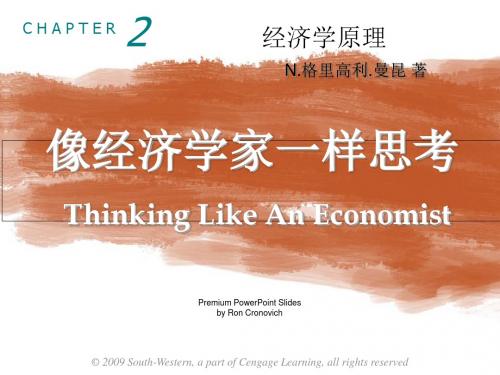
本章将探索这些问题的答案: In this chapter, look for the answers to these questions:
经济学家的两种角色是什么?怎样区别它们? What are economists’ two roles? How do they differ? 什么是模型?经济学家怎么使用它们? What are models? How do economists use them? 循环流程图的构成要素有哪些?流程图想要表达什么概念? What are the elements of the Circular-Flow Diagram? What concepts does the diagram illustrate?
macroeconomics? Between positive and normative?
1
作为科学家和作为政策顾问的经济学家
经济学家的两种角色/作用:
1. 2.
作为科学家:他们试图解释世界(explain the world)
作为政策顾问:他们尝试改善(改进)世界(improve it)
25,000
40,000 50,000
250
100 0
2,500
4,000 5,000
生产可能性边界:举例
图中 各点 A
B
产量
电脑 小麦
小麦 (吨 ) 6,000 5,000 4,000 3,000 2,000 1,000 0 0
E D
C
500
400
0
1,000
C
D E
250
100 0
2,500
4,000 5,000
经济学原理 曼昆Chapter_02_34902801

劳动,土地,资本
Wages, rent, and profit工资
of Production 生产要素市场
Income收入
13
、租金与利润
循环流向图
The Circular-Flow Diagram
企业Firms
生产和出售产品和服务Produce and sell goods and services
22
Cars Produced
坐标系中的双变量 Two Variables in the Coordinate System
• 理论预测变量之间的关系Theory predicts a causality relationship between variables
• 从数据中检验变量间的关系test the theory from data
20
Quantity of Computers Produced
4,000
3,000
2,100 2,000
The Production Possibiift in the production
possibilities frontier
生产可能性边界外移
对数据的经验(实证)分析 Empirical Analysis of Data
• How to present single variable data
圆形图Pie Chart 柱形图Bar Graph 时间序列图Time Series Graph
0
700 750 1,000
Quantity21of
假设应尽可能少 Fewer assumptions, the better
8
关于假设和结论 On Assumptions and Conclusions
曼昆经济学原理英文书

曼昆经济学原理英文书The Economics Principles by MankiwChapter 1: Ten Principles of EconomicsChapter 2: Thinking Like an EconomistChapter 3: Interdependence and the Gains from Trade Chapter 4: The Market Forces of Supply and Demand Chapter 5: Elasticity and Its ApplicationChapter 6: Supply, Demand, and Government Policies Chapter 7: Consumers, Producers, and Efficiency of Markets Chapter 8: Application: The Costs of TaxationChapter 9: Application: International TradeChapter 10: ExternalitiesChapter 11: Public Goods and Common Resources Chapter 12: The Design of the Tax SystemChapter 13: The Costs of ProductionChapter 14: Firms in Competitive MarketsChapter 15: MonopolyChapter 16: Monopolistic CompetitionChapter 17: OligopolyChapter 18: The Markets for Factors of Production Chapter 19: Earnings and DiscriminationChapter 20: Income Inequality and PovertyChapter 21: Introduction to MacroeconomicsChapter 22: Measuring a Nation's IncomeChapter 23: Measuring the Cost of LivingChapter 24: Production and GrowthChapter 25: Saving, Investment, and the Financial System Chapter 26: The Basic Tools of FinanceChapter 27: UnemploymentChapter 28: The Monetary SystemChapter 29: Money Growth and InflationChapter 30: Open-Economy Macroeconomics: Basic Concepts Chapter 31: A Macroeconomic Theory of the Open Economy Chapter 32: Aggregate Demand and Aggregate SupplyChapter 33: The Influence of Monetary and Fiscal Policy on Aggregate DemandChapter 34: The Short-Run Trade-Off between Inflation and UnemploymentChapter 35: The Theory of Consumer ChoiceChapter 36: Frontiers of MicroeconomicsChapter 37: Monopoly and Antitrust PolicyChapter 38: Oligopoly and Game TheoryChapter 39: Externalities, Public Goods, and Environmental Policy Chapter 40: Uncertainty and InformationChapter 41: Aggregate Demand and Aggregate Supply Analysis Chapter 42: Understanding Business CyclesChapter 43: Fiscal PolicyChapter 44: Money, Banking, and Central BankingChapter 45: Monetary PolicyChapter 46: Inflation, Disinflation, and DeflationChapter 47: Exchange Rates and the International Financial SystemChapter 48: The Short - Run Trade - Off between Inflation and Unemployment RevisitedChapter 49: Macroeconomic Policy: Challenges in the Twenty - First CenturyEpilogue: 14 Big IdeasNote: The chapter titles have been abbreviated for simplicity and brevity purposes.。
曼昆经济学第二章练习题
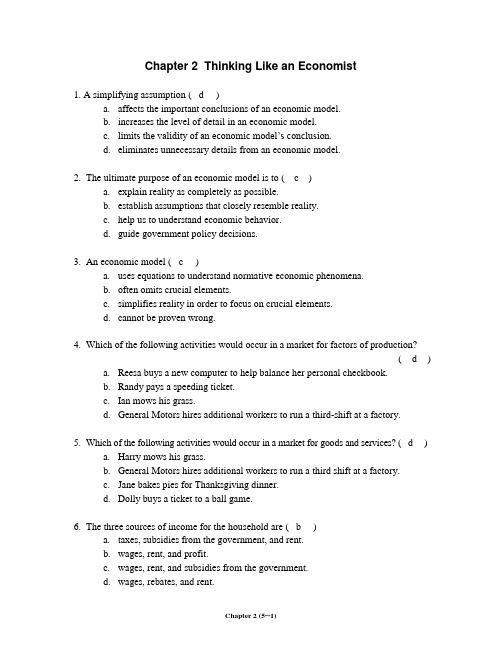
Chapter 2 Thinking Like an Economist1. A simplifying assumption ( d )a.affects the important conclusions of an economic model.b.increases the level of detail in an economic model.c.limits the validity of an economic model’s conclusion.d.eliminates unnecessary details from an economic model.2. The ultimate purpose of an economic model is to ( c )a.explain reality as completely as possible.b.establish assumptions that closely resemble reality.c.help us to understand economic behavior.d.guide government policy decisions.3. An economic model ( c )es equations to understand normative economic phenomena.b.often omits crucial elements.c.simplifies reality in order to focus on crucial elements.d.cannot be proven wrong.4. Which of the following activities would occur in a market for factors of production?( d )a.Reesa buys a new computer to help balance her personal checkbook.b.Randy pays a speeding ticket.c.Ian mows his grass.d.General Motors hires additional workers to run a third-shift at a factory.5. Which of the following activities would occur in a market for goods and services? ( d )a.Harry mows his grass.b.General Motors hires additional workers to run a third shift at a factory.c.Jane bakes pies for Thanksgiving dinner.d.Dolly buys a ticket to a ball game.6. The three sources of income for the household are ( b )a.taxes, subsidies from the government, and rent.b.wages, rent, and profit.c.wages, rent, and subsidies from the government.d.wages, rebates, and rent.7. Households play what role(s) in the circular flow diagram? ( d )a.purchasers of factors of production and sellers of services.b.purchasers of factors of production and sellers of goods.c.purchasers of goods and services only.d.purchasers of goods and services and sellers of factors of production.8. Which of the following is not an assumption that underlies an economy’s production possibilities frontier? ( c )a.fixed income.b.fixed resources.c.unchanged technology.d.fully employed resources.9. Which of the following would not result in an outward shift of a nation’s production possibilities frontier? ( )a. a reduction in the unemployment rate.b. a rise in labor productivity.c.advances in technology.d.an expanding resource base.10. The production possibilities frontier demonstrates the basic economic principle that( )a.economies are always efficient.b.assuming full employment, supply will always determine demand.c.assuming full employment, an economy is efficient only when the productionof capital goods in a particular year is greater than the production ofconsumption goods in that year.d.assuming full employment, to produce more of any one thing, the economymust produce less of at least one other good.11. Opportunity costs most often increase as you move down a production possibilities frontier because ( )a.resources are not completely adaptable to alternative uses.b.factors of production are limited and human wants are unlimited.c.efficiencies are generated by large-scale production.d.economic efficiency is only possible in the short run.12. Suppose an economy has the production possibilities frontier shown in the diagram and is operating at position A. Which of the statements below is false? ( )a.This economy could produce more of both capital and consumption goods.b.This economy is experiencing full employment.c.This economy could produce more capital goods without decreasing thequantity of consumption goods produced.d.This economy could produce more consumption goods without decreasing thequantity of capital goods produced.would know that ( )a.the rate of unemployment increased.b.consumption goods production increased, but capital goods productiondecreased.c.its unemployment decreased, but at the expense of either capital orconsumption good production.d.it has achieved full employment of resources.14. All points on a production possibilities frontier show the ( )a.maximum satisfaction that households receive from their purchases of goods.b.minimum quantities of resources that must be used to produce a givenquantity of output.c.maximum output that society can produce with given resources and technology.d.minimum output that society can produce with given resources and technology.15. The branch of economics that is concerned with the overall performance of the economy is called ( )a.resource economics.b.contemporary economics.c.macroeconomics.d.microeconomics.16. Which of the following questions would not be of particular interest to a microeconomist? ( )a.Why do national economies grow?b.What percentage of consumer income is spent on entertainment?c.Why do workers refer the 4-day workweek?d.What happens to worker productivity when the job shifts to a 4-day workweek?17. The television network newscaster reports that the national inflation rate in the past year equaled 4 percent. This report is most likely prepared from work done by a ( )a.microeconomist.b.normative economist.c.macroeconomist.d.social scientist rather than an economist.18. The Secretary of Labor states that wage rates in the country have risen by 2 percent this past year. The head of a local labor union states that wage gains should have been higher. The Secretary’s statement is a _________________ economic statement, and the labor head’s statement is a __________________economic statement. ( )a.normative; normativeb.normative; positivec.positive; normatived.positive; positive19. “An increase in interest rates will lower economic growth.” This statement is ( )a. a positive economic statement.b. a normative economic statement.c.untrue in every case.d.controversial, and so not a valid economic issue.20. The distinction between positive and normative economics ( )a.is that positive economics applies only to microeconomic problems.b.is that normative economics applies only to microeconomic problems.c.explains why economics is not a social science but a natural science.d.helps us to understand why economists sometimes disagree with one another.21. Which of the following is most closely associated with positive economics? ( )a.Determining the impact of government spending on the actual level of totalemployment.b.Determining the best level of immigration into a country.c.Determining whether too many luxury goods are being produced.d.Determining whether or not the government should reduce poverty.22. If two variables tend to increase and decrease together, they are ( )a.positively correlated.b.negatively correlated.c.uncorrelated.d.quasi-correlated23. The number of rainy days in the year and annual sales of suntan lotion are probably( )a.positively correlated.b.negatively correlated.c.uncorrelated.d.quasi-correlated.24. A student’s course grade and amount of time spent studying the for course are generally ( )a.positively correlated.b.negatively correlated.c.uncorrelated.d.quasi-correlated.Ch021) d2) c3) c4) d5) d6) b7) d8) a9) a10)d11)a12)b13)d14)c15)c16)a17)c18)c19)a20)d21)a22)a23)b24)a。
Chapter 2 Thinking_like_an_economist
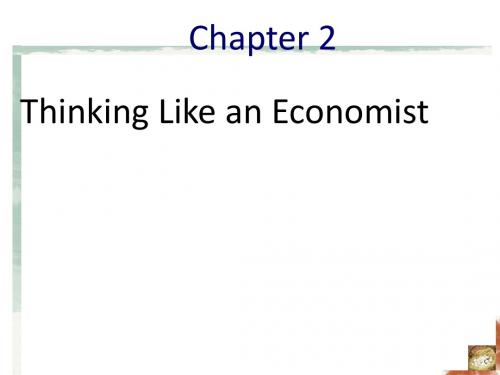
The Economist as a Scientist
Our second model: The production possibilities frontier • Production possibilities frontier (PPF)
– A graph – Combinations of output that the economy can possibly produce – Given the available factors of production and production technology
– Firms – buyers – Households - sellers
9
Figure 1 The circular flow
This diagram is a schematic representation of the organization of the economy. Decisions are made by households and firms. Households and firms interact in the markets for goods and services (where households are buyers and firms are sellers) and in the markets for the factors of production (where firms are buyers and households are sellers). The outer set of arrows shows the flow of dollars, and the inner set of arrows shows the corresponding flow of inputs and outputs. 10
MCh_02 Thinking Like an Economist
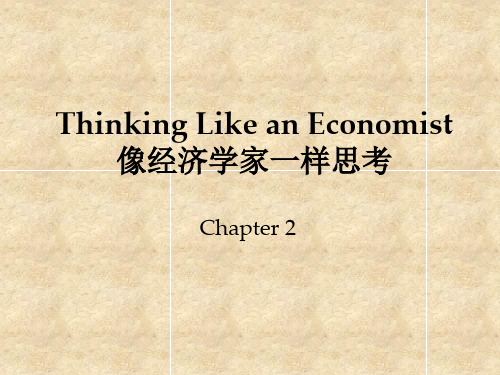
Analytical (abstract reasoning)分析的(抽象推理)
The Scientific Method 科学的方法
• Observation (观察) • Theory (理论) • And More Observation (更多的观察)
– 使用科学的方法
• Uses abstract models to help explain how a complex, real world operates.
– 使用抽象的模型来帮助解释一个复杂的真实世界是如何 运行的。
• Develops theories, collects and analyzes data to evaluate the theories.
About the Individual Behavior(关于个人行为)
– Scarcity (稀缺性) – Opportunity Cost (机会成本) – Tradeoff (权衡)
The Economic Perspective 经济学的视角
About Multi-Person Decisionmaking关于多 人决策: • Equilibrium (均衡) • Efficiency (效率) • Win-Win (是否双赢)
– 提出理论,收集并分析数据以检验理论
The Economic Way of Thinking 经济学的思考方式
钱颖一 (2002) • Perspective (视角) • Reference or Benchmark(参照系或基准点) • Analytic Tools (分析工具)
曼昆经济学原理第二章
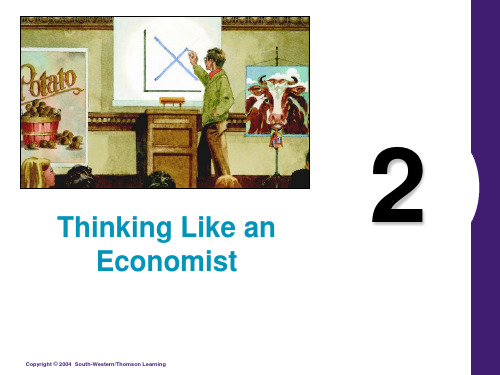
Factors of production
Wages, rent, and profit
MARKETS FOR
Labor, land, and capital
FACTORS OF PRODUCTION
•Households sell •Firms buy
Income
= Flow of inputs and outputs
• Economists use models to simplify reality in order to improve our understanding of the world
• Two of the most basic economic models include:
• The Circular Flow Diagram • The Production Possibilities Frontier
• Called prescriptive analysis
Copyright © 2004 South-Western/Thomson Learning
POSITIVE VERSUS NORMATIVE
ANALYSIS
• Positive or Normative Statements?
• Firms sell • Households buy
• Markets for Factors of Production
• Households sell • Firms buy
Copyright © 2004 South-Western/Thomson Learning
Our First Model: The Circular-Flow Diagram • Factors of Production
经济学原理 Chapter 2
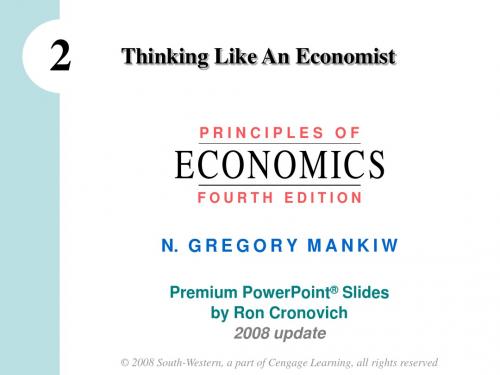
Answers Point G:
300 computers, 3500 tons wheat
1:
Wheat (tons) 6,000 5,000 4,000 3,000 2,000 1,000 0 0 100 200 300 400 500 600 Computers
18
Point G requires
Example:
• Two goods: computers and wheat • One resource: labor (measured in hours) • Economy has 50,000 labor hours per month
available for production.
Factors of Production
Factors of production: the resources the
economy uses to produce goods & services, including • labor • land • capital (buildings & machines used in production)
7
Our First Model:
The Circular-Flow Diagram
The Circular-Flow Diagram: A visual model of
the economy, shows how dollars flow through markets among households and firms.
CHAPTER 2
THINKING LIKE AN ECONOMIST
2
Assumptions & Models
曼昆经济学第二章练习题
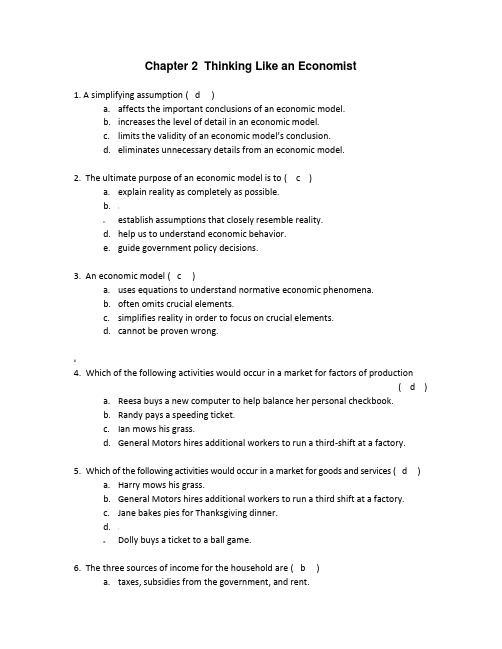
Chapter 2 Thinking Like an Economist1. A simplifying assumption ( d )a.affects the important conclusions of an economic model.b.increases the level of detail in an economic model.c.limits the validity of an economic model’s conclusion.d.eliminates unnecessary details from an economic model.2. The ultimate purpose of an economic model is to ( c )a.explain reality as completely as possible.b.:c.establish assumptions that closely resemble reality.d.help us to understand economic behavior.e.guide government policy decisions.3. An economic model ( c )es equations to understand normative economic phenomena.b.often omits crucial elements.c.simplifies reality in order to focus on crucial elements.d.cannot be proven wrong.#4. Which of the following activities would occur in a market for factors of production( d )a.Reesa buys a new computer to help balance her personal checkbook.b.Randy pays a speeding ticket.c.Ian mows his grass.d.General Motors hires additional workers to run a third-shift at a factory.5. Which of the following activities would occur in a market for goods and services ( d )a.Harry mows his grass.b.General Motors hires additional workers to run a third shift at a factory.c.Jane bakes pies for Thanksgiving dinner.d.-e.Dolly buys a ticket to a ball game.6. The three sources of income for the household are ( b )a.taxes, subsidies from the government, and rent.b.wages, rent, and profit.c.wages, rent, and subsidies from the government.d.wages, rebates, and rent.7. Households play what role(s) in the circular flow diagram ( d )a.purchasers of factors of production and sellers of services.b.purchasers of factors of production and sellers of goods.c.!d.purchasers of goods and services only.e.purchasers of goods and services and sellers of factors of production.8. Which of the following is not an assumption that underlies an economy’s production possibilities frontier ( c )a.fixed income.b.fixed resources.c.unchanged technology.d.fully employed resources.9. Which of the following would not result in an outward shift of a nation’s production possibilities frontier ( )a.]b. a reduction in the unemployment rate.c. a rise in labor productivity.d.advances in technology.e.an expanding resource base.10. The production possibilities frontier demonstrates the basic economic principle that( )a.economies are always efficient.b.assuming full employment, supply will always determine demand.c.assuming full employment, an economy is efficient only when the productionof capital goods in a particular year is greater than the production ofconsumption goods in that year.d.assuming full employment, to produce more of any one thing, the economymust produce less of at least one other good.【11. Opportunity costs most often increase as you move down a production possibilities frontier because ( )a.resources are not completely adaptable to alternative uses.b.factors of production are limited and human wants are unlimited.c.efficiencies are generated by large-scale production.d.economic efficiency is only possible in the short run.12. Suppose an economy has the production possibilities frontier shown in the diagram and is operating at position A. Which of the statements below is false ( )a.This economy could produce more of both capital and consumption goods.b.This economy is experiencing full employment.c.This economy could produce more capital goods without decreasing thequantity of consumption goods produced.d.~e.This economy could produce more consumption goods without decreasingthe quantity of capital goods produced.:13. If the economy shown in the diagram moves from position A to position B, we would know that ( )a.the rate of unemployment increased.b.consumption goods production increased, but capital goods productiondecreased.c.its unemployment decreased, but at the expense of either capital orconsumption good production.d.it has achieved full employment of resources.14. All points on a production possibilities frontier show the ( )a.maximum satisfaction that households receive from their purchases of goods.b.minimum quantities of resources that must be used to produce a givenquantity of output.c.maximum output that society can produce with given resources and technology.d..e.minimum output that society can produce with given resources and technology.15. The branch of economics that is concerned with the overall performance of the economy is called ( )a.resource economics.b.contemporary economics.c.macroeconomics.d.microeconomics.16. Which of the following questions would not be of particular interest to a microeconomist ( )a.Why do national economies growb.What percentage of consumer income is spent on entertainmentc.)d.Why do workers refer the 4-day workweeke.What happens to worker productivity when the job shifts to a 4-dayworkweek17. The television network newscaster reports that the national inflation rate in the past year equaled 4 percent. This report is most likely prepared from work done by a ( )a.microeconomist.b.normative economist.c.macroeconomist.d.social scientist rather than an economist.18. The Secretary of Labor states that wage rates in the country have risen by 2 percent this past year. The head of a local labor union states that wage gains should have been higher. The Secretary’s statement is a _________________ economic statement, and the labor head’s statement is a __________________economic statemen t. ( )a.、b.normative; normativec.normative; positived.positive; normativee.positive; positive19. “An increase in interest rates will lower economic growth.” This statement is ( )a. a positive economic statement.b. a normative economic statement.c.untrue in every case.d.controversial, and so not a valid economic issue.<20. The distinction between positive and normative economics ( )a.is that positive economics applies only to microeconomic problems.b.is that normative economics applies only to microeconomic problems.c.explains why economics is not a social science but a natural science.d.helps us to understand why economists sometimes disagree with oneanother.21. Which of the following is most closely associated with positive economics ( )a.Determining the impact of government spending on the actual level of totalemployment.b.Determining the best level of immigration into a country.c.|d.Determining whether too many luxury goods are being produced.e.Determining whether or not the government should reduce poverty.22. If two variables tend to increase and decrease together, they are ( )a.positively correlated.b.negatively correlated.c.uncorrelated.d.quasi-correlated23. The number of rainy days in the year and annual sales of suntan lotion are probably( )a.>b.positively correlated.c.negatively correlated.d.uncorrelated.e.quasi-correlated.24. A student’s course grade and amount of time spent studying the for course are generally ( )a.positively correlated.b.negatively correlated.c.uncorrelated.d.quasi-correlated.>Ch021)d2)c3)c4)~5)d6)d7)b8)d9)a10)a11)d12)a13)b14)d15)c16)c17)a18)c19)c20)a21)d22)a23)a24)b25)a。
曼昆微观经济学 第二章
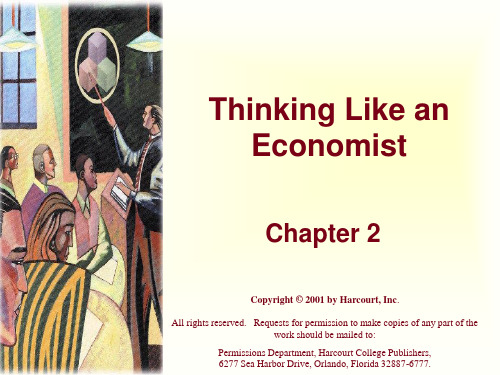
Positive versus Normative Analysis
Positive statements are statements that describe the world as it is.
4,000
3,000
2,100 2,000
The Production Possibilities Frontier
E A
An outward shift in the production
possibilities frontier
0
700 750
Harcourt, Inc. items and derived items copyright © 2001 by Harcourt, Inc.
The Scientific Method
Uses abstract models to help explain how a complex, real world operates. Develops theories, collects, and analyzes data to prove the theories.
The Circular-Flow Diagram
Revenue
Goods & Services sold
Market for Goods
and Services
Spending
Goods & Services bought
Firms
Households
Inputs for production
Chapter 2 Thinking Like An Economist微观经济学
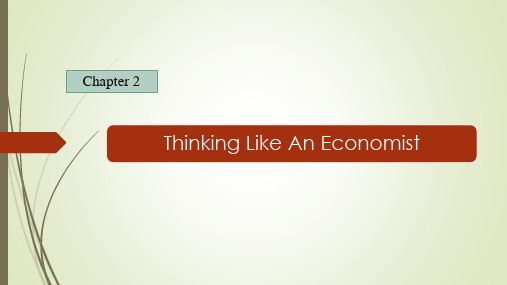
Some Familiar Models
A model of human anatomy from high school biology class
7
THINKING LIKE AN ECONOMIST
Some Familiar Models
A model irplane
8
THINKING LIKE AN ECONOMIST
Two markets: the market for goods and services the market for “factors of production”
10
THINKING LIKE AN ECONOMIST
Factors of Production
Factors of production: the resources the economy uses to produce goods & services, including
possible
not efficient: some resources underutilized (e.g., workers unemployed, factories idle)
Points above the PPF (like G)
20 not possible
THINKING LIKE AN ECONOMIST
0 0
G
100 200 300 400 500 600 Computers
19
The PPF: What We Know So Far
Points on the PPF (like A – E)
possible
efficient: all resources are fully utilized
曼昆经济学原理第二章
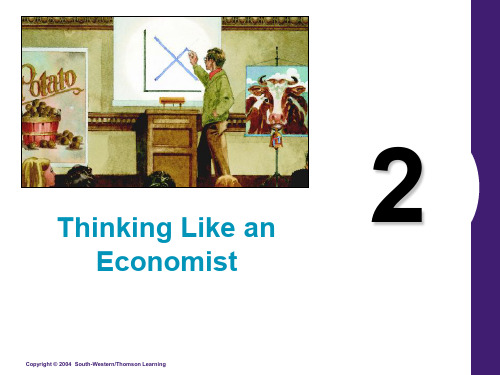
possibilities
B
frontier
0
300
600 700
1,000 Quantity of
Cars Produced Copyright©2003 Southwestern/Thomson Learning
Our Second Model: The Production Possibilities Frontier • Concepts Illustrated by the Production
Possibilities Frontier
• Efficiency • Tradeoffs • Opportunity Cost • Economic Growth
Copyright © 2004 South-Western/Thomson Learning
Figure 3 A Shift in the Production Possibilities Frontier
• Microeconomics focuses on the individual parts of the economy.
• How households and firms make decisions and how they interact in specific markets
• Macroeconomics looks at the economy as a whole.
Spending
Goods and services bought
FIRMS •Produce and sell goods and services •Hire and use factors of production
HOUSEHOLDS •Buy and consume goods and services •Own and sell factors of production
Unit 2 Thinking Like an Economist
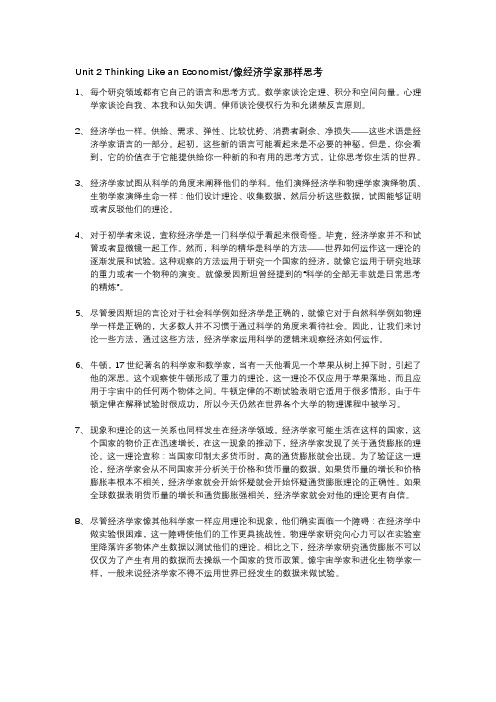
Unit 2Thinking Like an Economist/像经济学家那样思考1、每个研究领域都有它自己的语言和思考方式。
数学家谈论定理、积分和空间向量。
心理学家谈论自我、本我和认知失调。
律师谈论侵权行为和允诺禁反言原则。
2、经济学也一样。
供给、需求、弹性、比较优势、消费者剩余、净损失——这些术语是经济学家语言的一部分。
起初,这些新的语言可能看起来是不必要的神秘。
但是,你会看到,它的价值在于它能提供给你一种新的和有用的思考方式,让你思考你生活的世界。
3、经济学家试图从科学的角度来阐释他们的学科。
他们演绎经济学和物理学家演绎物质、生物学家演绎生命一样:他们设计理论、收集数据,然后分析这些数据,试图能够证明或者反驳他们的理论。
4、对于初学者来说,宣称经济学是一门科学似乎看起来很奇怪。
毕竟,经济学家并不和试管或者显微镜一起工作。
然而,科学的精华是科学的方法——世界如何运作这一理论的逐渐发展和试验。
这种观察的方法运用于研究一个国家的经济,就像它运用于研究地球的重力或者一个物种的演变。
就像爱因斯坦曾经提到的“科学的全部无非就是日常思考的精炼”。
5、尽管爱因斯坦的言论对于社会科学例如经济学是正确的,就像它对于自然科学例如物理学一样是正确的,大多数人并不习惯于通过科学的角度来看待社会。
因此,让我们来讨论一些方法,通过这些方法,经济学家运用科学的逻辑来观察经济如何运作。
6、牛顿,17世纪著名的科学家和数学家,当有一天他看见一个苹果从树上掉下时,引起了他的深思。
这个观察使牛顿形成了重力的理论,这一理论不仅应用于苹果落地,而且应用于宇宙中的任何两个物体之间。
牛顿定律的不断试验表明它适用于很多情形。
由于牛顿定律在解释试验时很成功,所以今天仍然在世界各个大学的物理课程中被学习。
7、现象和理论的这一关系也同样发生在经济学领域。
经济学家可能生活在这样的国家,这个国家的物价正在迅速增长,在这一现象的推动下,经济学家发现了关于通货膨胀的理论。
- 1、下载文档前请自行甄别文档内容的完整性,平台不提供额外的编辑、内容补充、找答案等附加服务。
- 2、"仅部分预览"的文档,不可在线预览部分如存在完整性等问题,可反馈申请退款(可完整预览的文档不适用该条件!)。
- 3、如文档侵犯您的权益,请联系客服反馈,我们会尽快为您处理(人工客服工作时间:9:00-18:30)。
Harcourt, Inc. items and derived items copyright © 2001 by Harcourt, Inc.
The Economic Way of Thinking
Includes
developing abstract models from theories and the analysis of the models. Uses two approaches:
Quantity of Computers Produced 4,000
The Production Possibilities Frontier
An outward shift in the production possibilities frontier
3,000
2,100 2,000
E
A
0
The Production Possibilities Frontier
The production possibilities frontier is a graph showing the various combinations of output that the economy can possibly produce given the available factors of production and technology.
Harcourt, Inc. items and derived items copyright © 2001 by Harcourt, Inc.
The Circular-Flow Diagram
Firms
Produce and sell goods and services Hire and use factors of production Households
Thinking Like an Economist
Chapter 2
Copyright © 2001 by Harcourt, Inc. All rights reserved. Requests for permission to make copies of any part of the work should be mailed to: Permissions Department, Harcourt College Publishers, 6277 Sea Harbor Drive, Orlando, Florida 32887-6777.
Quantity of Computers Produced
3,000
D
2,200 2,000
C
A
Production possibilities frontier
1,000
B
0
300
600 700
1,000
Harcourt, Inc. items and derived items copyright © 2001 by Harcourt, Inc.
Every field of study has its own terminoΒιβλιοθήκη ogyMathematics
integrals
axioms vector spaces
Psychology
ego
id
torts
Law
cognitive dissonance
Promissory estoppel venues
Harcourt, Inc. items and derived items copyright © 2001 by Harcourt, Inc.
The Scientific Method
Uses
abstract models to help explain how a complex, real world operates.
700 750
1,000
Harcourt, Inc. items and derived items copyright © 2001 by Harcourt, Inc.
Quantity of Cars Produced
Microeconomics and Macroeconomics
Microeconomics focuses
a whole.
How the markets, as a whole, interact at the national level.
on the individual
parts of the economy.
How households and firms make decisions and how they interact in specific markets
Macroeconomics
looks at the economy as
Harcourt, Inc. items and derived items copyright © 2001 by Harcourt, Inc.
The Production Possibilities Frontier
Quantity of Computers Produced
3,000
D
2,200 2,000
Quantity of Cars Produced
Concepts Illustrated by the Production Possibilities Frontier
Efficiency Tradeoffs
Opportunity
Cost Economic Growth
Harcourt, Inc. items and derived items copyright © 2001 by Harcourt, Inc.
Harcourt, Inc. items and derived items copyright © 2001 by Harcourt, Inc.
The Economist as a Scientist
The economic way of thinking . . .
Involves
thinking analytically and objectively. Makes use of the scientific method.
Markets for Goods & Services
Firms sell Households buy Markets for Factors of Production
Households sell
Firms buy
Harcourt, Inc. items and derived items copyright © 2001 by Harcourt, Inc.
Comparative advantage
Harcourt, Inc. items and derived items copyright © 2001 by Harcourt, Inc.
Consumer Surplus Demand Deadweight loss
Economics trains you to. . . .
Harcourt, Inc. items and derived items copyright © 2001 by Harcourt, Inc.
Every field of study has its own terminology
Economics
Supply Opportunity cost Elasticity
The Role of Assumptions
Economists make assumptions in order to make the world easier to understand. The art in scientific thinking is deciding which assumptions to make. Economists use different assumptions to answer different questions.
Spending Goods & Services bought
Firms
Households
Inputs for production Wages, rent, and profit
Market for Factors of Production
Labor, land, and capital Income
Think
in terms of alternatives. Evaluate the cost of individual and social choices. Examine and understand how certain events and issues are related.
Economists use models to simplify reality in order to improve our understanding of the world Two of the most basic economic models include:
The Circular Flow Model The Production Possibilities Frontier
Develops
theories, collects, and analyzes data to prove the theories.
Observation, Theory and More Observation!
Harcourt, Inc. items and derived items copyright © 2001 by Harcourt, Inc.
